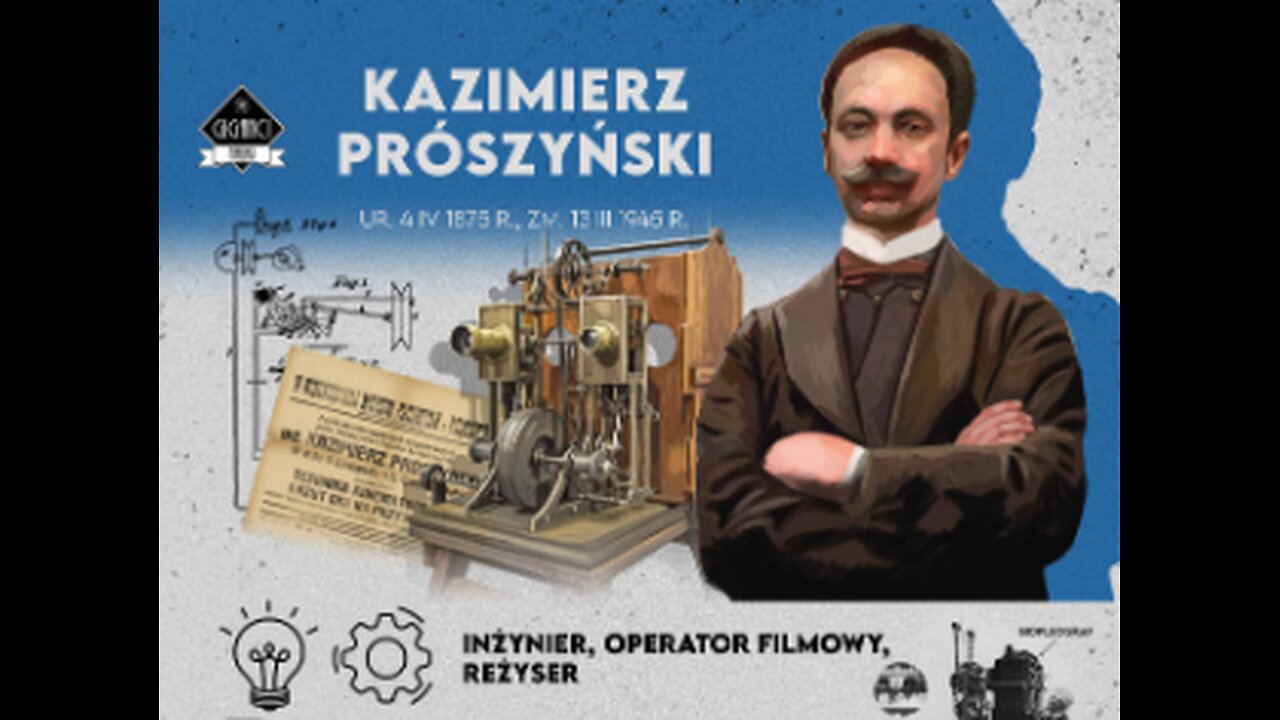Premium Only Content

Polish Genius : Kazimierz Proszynski
Kazimierz Prószyński: a pioneer of world cinematography
Kazimierz Prószyński was a cinematographer, director and inventor whose importance in the development of cinematography was highlighted by the famous Lumière brothers. He was born on 4 April 1875 in Warsaw and was the son of Konrad, an educational activist, founder of the National Education Society and publisher whose “Primer” was awarded the main prize at the London Pedagogical Society exhibition in 1893. As a student, the future inventor showed a great talent for science and after graduating from high school his father sent him to study at a polytechnic in Liège, Belgium.
In 1894, the nineteen-year-old Pole built a pleograph, a device for recording and playing back films. Although the invention did not come into common use and was not patented, Prószyński made his first films with it for which he deserves to be called the precursor of world cinema. A similar camera was constructed and patented by the Lumière brothers, who in 1895 organized a public film screening in Paris (“Workers Leaving the Factory”). During one of the shows, Louis Lumière was rumored to have said: “Gentlemen, this man [Prószyński] is the first in cinematography, I am the second.” The first viewers of the short films presented in the last years of the 19th century must have been irritated by the constant shaking of the picture. Prószyński constantly worked on improving his machine and thanks to his development of a leaf shutter to reduce vibrations, he was able to virtually eliminate blur in the image. This device, called the obturator, was recognized by the French Academy of Sciences as a “groundbreaking invention” and is still used in cameras today. The Daumont company put it into production but as Prószyński was not a skillful businessman he never benefitted from his invention.
In 1897, Prószyński patented a device in Berlin called the universal expeditor for folding newspapers in printing houses; many European publishers used them. Four years later, he founded the film company Towarzystwo Kapitałowe Pleograf in Warsaw, where he promoted his films depicting the everyday life of the city (including “Traffic Street in front of the Mickiewicz Monument”, “Adventure of a cabman”, “Skating rink in the park Dolina Szwajcarska”). The first film screenings took place at the Summer Theater in the Saski Garden. In 1907, he constructed a cinematograph, a device that allows for the simultaneous emission of image and sound. Prószyński was not effective at self-promotion, hence his contributions to the development of sound films were largely forgotten. Later, he worked on a handheld film camera, called an Aeroscope, which he patented in France and Great Britain, where he had settled in 1911. With his camera he made the first Polish film report of the coronation of George V. Soon he equipped the Aeroscope with a mechanism that reduced vibrations and replaced the pneumatic drive with an electric one. From then on, the camera was powered by a battery in a backpack. He wrote about his breakthrough invention in “The Photographic Journal”. “Equipped with such a camera, we can film the most unexpected things, following every movement with the same speed as a hunter guides a shotgun after a flying bird”.
The handheld camera by Prószyński was highly successful and remained in common use until the 1930s. In 1913, the invention was awarded a gold medal at the International Cinematographic Exhibition in London. It was used by Cherry Karton, a traveler, author of the first nature films and war reporter and during the First World War, it was used to record events on the front lines. Frederic Talbot in his book “Moving Picture” (1912) described the Aeroscope as “the best and simplest camera known to date in cinematography, giving better results and enormous benefits due to the fact that it allows you to film with your hand, from any position, and that you just need to press a button with your finger to run it.” Prószyński also worked on a film camera for use by amateurs and hobbyists. He called it “The Eye” and presented it to the Royal Photographic Society in London. Unfortunately, due to the beginning of the armed conflict and the subsequent economic crisis, the device was not successful on the market. Prószyński’s Central European Film Factory, founded in Warsaw, went bankrupt after three years. In 1919, the inventor returned to Poland and throughout the interwar period he worked on improving his own technical solutions. During the Second World War, he was involved in underground activities. In 1944, after the fall of the Warsaw Uprising, he was arrested and imprisoned by Germans in the Mauthausen concentration camp where he died on 13 March 1945.
Prószyński made 11 documentary films, 5 silent feature films and two sound feature films. Among his breakthrough inventions, apart from discoveries in the field of cinematography, he also invented the autolector (a tool that enabled the visually-impared to read) and the telephoto, a device for transmitting images, thanks to which he should be mentioned as one of the fathers of television. Even today, although they have been modernized and miniaturized, many of his technical ideas are still in use.
Author: Piotr Bejrowski
Translation: Mikołaj Sekrecki
-
 LIVE
LIVE
MDGgamin
15 hours ago🔴LIVE -TARKOV & Path Of Exile 2- Live Long Enough To Become The Villain. - #RumbleTakeover
246 watching -
 2:05:21
2:05:21
Joker Effect
5 hours agoRumble is all freedom of speech! @PlayMotherland and @IGGYAZALEA bring a great genre! The games are lit af!
24.8K1 -
 58:42
58:42
The Amber May Show
13 hours ago $4.20 earnedWomen Of Rumble 04-15-25
48.6K1 -
 4:49
4:49
The Official Steve Harvey
1 day agoSteve Harvey's Motivational Talks 💭✨ Dream Big, Work Hard, and Make It Happen! ✨💭
80.9K7 -
 3:11:08
3:11:08
RaikenNight
5 hours ago $1.97 earnedTime To Go On A Hunt
29.7K2 -
 2:10:55
2:10:55
Purrfect Pixie's Cozy Spot
6 hours agoPixie Plays: World of Warcraft Cataclysm Classic: Dragon Soul Raid
29K1 -
 1:14:28
1:14:28
AlaskanBallistics
5 hours ago $0.73 earnedI love this Gun PodCast #26
20.6K5 -
 6:03:01
6:03:01
yellow_1ron
6 hours ago $0.77 earnedFIRST EVER RUMBLE STREAM | MARVEL RIVALS | WARZONE | JOIN UP!!!
15.8K3 -
 30:08
30:08
QNewsPatriot
13 hours ago(4/14/2025) | AUDIO CHAT 160 | SG Sits Down w/ CA Patriots "The Shasta Five": Election Security Efforts in Deep Blue California
29.7K8 -
 1:25:40
1:25:40
Anthony Rogers
1 day agoEpisode 361 - Stargates & Ancient Civilizations
12.4K